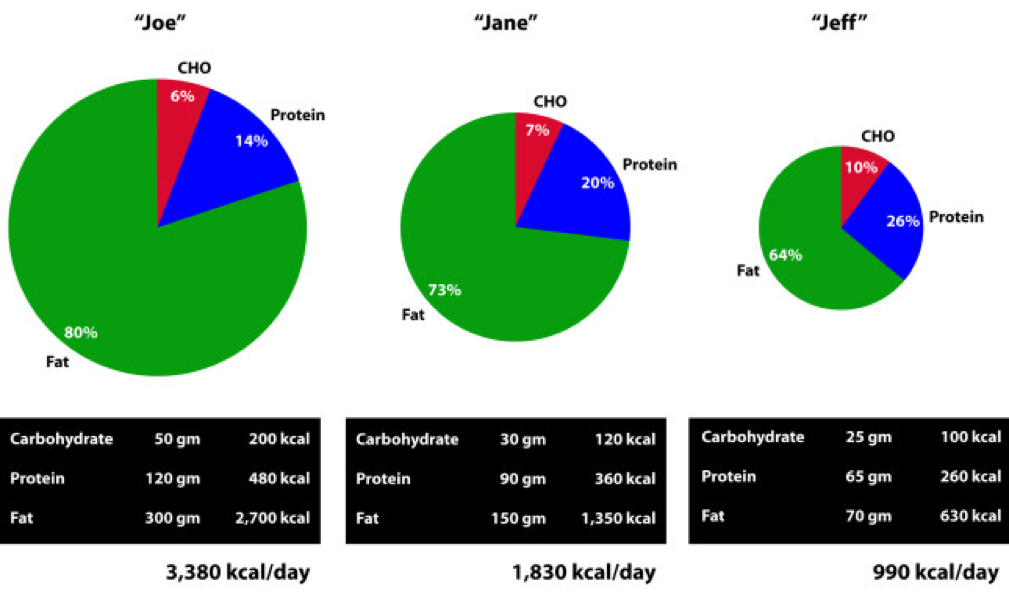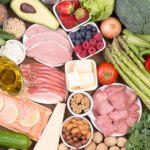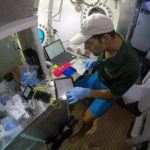For reasons I’m still struggling to understand, the idea of “nutritional ketosis” (NK, to be distinguished from starvation ketosis, SK or diabetic ketoacidosis, DKA) is often discussed and debated in much the same way as religion or politics. Perhaps this can be said of all nutrition, which is a shame. Nevertheless, in my continued defiance of such sensitive topics, I’d like to add another layer of complexity and nuance to this discussion.
The “rule of thumb” for NK is that caloric intake is determined as follows (this excludes a subset of ketogenic diets known as calorie-restricted KD which, as the name suggests, is specifically restricted in calories):
- Carbohydrate (total, not “net”): less than 50 gm/day, but ideally closer to 30 gm/day
- Protein: up to 1 to 1.5 gm/kg, but ideally below about 120 gm/day
- Fat: to satiety
Let me illustrate what this looks like for Joe (left), Jane (middle), and Jeff (right — an example of a calorie restricted KD), three hypothetical people in NK — but each with different caloric requirements.
As a general rule, as caloric requirement increases the proportion of calories derived from carbohydrate and protein decreases (and the contribution of dietary fat increases), even while absolute intake of carbohydrate and protein increases.
Anyone who has bought a blood ketone meter knows how tough it can be to get “into” ketosis by carbohydrate restriction (since everyone asks, I use the Abbott Precision Xtra meter which uses two different strips: one for glucose and one for beta-hydroxybutyrate, or BHB). Most practitioners consider the minimum threshold of NK to be a fasting serum level of BHB above 0.5 mM. I’m a bit more stringent in my practice and like to see fasting BHB levels above 1 mM. To give you a sense of one person’s numbers (mine), over a 6-month stretch in 2013, when I was in NK, my mean (i.e., arithmetic average) morning fasting level was 1.7 mM with a median value of 1.4 mM. The highest morning level during that period was 5.2 mM. (The highest morning level I have ever measured in myself is 5.7 mM.)
But, it took me a long time to get it right, especially since at the outset of my foray into NK I was consuming between 4,000 and 4,400 kcal per day. (My average daily caloric intake for weight stability was about 3,800 kcal per day, which was validated by doubly-labeled water.) I could still easily “fall out” of NK. For example, on my daughter’s 5th birthday she insisted I have some of her tikka masala (contains lots of sugar), naan bread, and mango ice cream. How could I say no to a birthday girl who insisted on going to the nicest Indian restaurant in San Diego? As to be expected, the next day my BHB was 0.2 mM, and it took me 2 days to get back above 1 mM.
Here’s a little secret I’m about to let everyone in on… I like carbohydrates. I love sushi (though I now mostly eat sashimi). I love Indian and Thai food, though I prefer to make curry myself to keep sugar out. I make (and eat) the best hummus this side of the Nile River. I’ve figured out how and when I can eat them to meet the following conditions:
- Stay in NK (except on a few occasions like my daughter’s birthday);
- Increase my anaerobic performance;
- Preserve most (but not all*) of the benefits I enjoyed when I was much more strict about my ketogenic diet.
How, you ask? By learning to calculate my glycogen deficit.
(*) For me, the leanest body composition I achieved as an adult was in strict NK with no attempts to do what I’m about to describe below. Since I’m not a model and nobody cares if my body fat is 7% or 10%, I’m happy to be a little less lean if it gives me the flexibility to increase performance and live a slightly more sane life. At least for now.
PLEASE NOTE: I have never suggested, and can’t imagine I ever will suggest, that a KD is “best” or “right” for everyone. What I describe below may seem extreme, both in the amount of work required and the actual application. I fully acknowledge that (1) this is a highly analytical approach to eating, and (2) that I’m a “freak” (my wife’s words, not mine). I certainly don’t do this often, unless a lot is on the line (e.g., a big ride), but I like having this technique in my armamentarium.
If you’ve watched my presentation from 2013 at the IHMC, then you’re familiar with RQ. Through years of metabolic testing I have a pretty good sense of my RQ at any moment in time – when I’m sleeping, when I’m sitting around (most of the time), when I’m riding my bike at 200 watts, when I’m riding my bike at 400 watts, when I’m lifting weights, etc. This allows me to calculate what proportion of my energy I derive from glycogen and what proportion I derive from fatty acid. Consider the following example:
If I ride my bike at an average of 185 watts (you’ll need a power meter to infer this) for, say, 2 hours, I know my average RQ is between 0.76 and 0.80.
The approximate formula is %CHO = 3.333*RQ – 2.333, which can easily be derived from the observation that %CHO utilized increases linearly from 0% at RQ 0.7 to 100% at RQ 1.0.
Furthermore, I know my VO2 at 185 watts is 2.9 liters per min, which means (using the Weir formula which I presented previously) my energy requirement was about 14 kcal per minute, or 1,680 kcal over 2 hours. Hence, of these 1,680 kcal needed to pedal 185 watts for 120 minutes, 336 to 554 kcal came from glycogen. In other words, I utilized between 84 and 138 gm of glycogen.
(By comparison, several years prior to being in NK, this effort in me would have taken place at a slightly higher VO2 – closer to 3.2 liters per min – and at a much higher RQ – between 0.90 and 0.95 – meaning the exact same work output would have required somewhere between 300 and 400 gm of glycogen! That’s a real state of metabolic inflexibility. Basically, I was entirely dependent on carbohydrates for energy.)
Since the first metabolic priority for ingested carbohydrate is glycogen replenishment, I can, in this setting, consume probably somewhere between 60 and 120 gm of carbohydrate following this ride and stay in ketosis. Why? Because those carbohydrates are prioritized to replenish my glycogen stores AND I am highly insulin sensitive. Note the *AND* in this last sentence. (The especially astute reader will realize some of this glycogen debt will be replenished by protein and glycerol, the latter of which is liberated by lipolysis – see post on fat flux for a primer).
Clearly I didn’t consume this amount of carbohydrate on my daughter’s birthday, so why was I out of ketosis the next day? Because my glycogen debt was not high. Of course, I knew this and didn’t really care. But, if I know my wife wants to go out for sushi one night, and I know she’s going to make me eat a California roll, I can “rig it” such that I show up to dinner with a glycogen debt appropriate enough to enjoy them without significantly interfering with my liver’s BHB production.
Extreme example
At one point, I did two tough bike rides on consecutive days. Each day we rode 110 miles under challenging conditions. Over 6,000 feet of climbing each day and very strong winds, which were either headwinds or cross-winds. On top of this, we rode pretty fast. For the purpose of illustration I recorded everything I did and ate on the second day, which I rode a bit easier than the first day.
The second ride took 6 hours and 5 minutes. My average normalized power output was 225 watts, and arithmetic average power output was 184 watts. Based on mechanical work output, this required about 5,000 kcal. Factoring in the other 18 hours of that day, my total energy expenditure was about 6,800 kcal for the day, obviously not an average day. (A detailed explanation of where the extra 1,800 kcal were expended is beyond what I want to get into now, but it’s basically the energy required to keep me alive – transport ions, contract voluntary and involuntary muscles, etc. — plus move me around, and digest food).
So what did I eat that day?
- Breakfast (pre-ride): 5 scrambled eggs, 2 sausage links, 3 pieces of bacon, coffee with cream.
- In ride nutrition (I spread this out over 6 hours): 14 oz (not a typo) of salted cashews, 2 Quest bars, 1 peach, 1 apple, 6 bottles of Biosteel High Performance Sports Drink, water. (Since I know someone will ask, I did not consume super starch this day since I was craving cashews as my carbohydrate source and was craving more sodium, given the 90+ degree temperature.)
- Late lunch/early dinner (post-ride): 2 oz ham, 3 oz pulled pork, large salad with oil and vinegar dressing, 2 slices of cheddar cheese, 6 mini hamburger patties, 2 tomatoes.
What did this amount to?
- Fat – 351 gm, or 3,160 kcal of fat
- Protein – 245 gm, or 980 kcal of protein
- Carbohydrate – 321 gm, or 1,284 kcal of carbohydrate
(I used package information and Nutritionist Pro software to calculate this.)
Hence, on this day I consumed about 5,400 kcal in total at the following ratio:
- Fat – 58%
- Protein – 18%
- Carbohydrate – 24%
By all conventional wisdom I should not have been in ketosis the next morning, right?
The following morning, my BHB level was 2.2 mM and blood glucose was 5.1 mM.
Teaching point I can’t resist: Following 2 days of significant caloric deficit, about 3,000 kcal in total, I should have in theory lost about a pound (mostly fat, possibly some muscle) which would have been noticed on a scale. Instead, I gained 8 pounds over those 2 days! Sure it was mostly water retention, both from the glycogen (small) and the fluid accumulating in the interstitial space (“thirds space” fluid losses, large) due to a systemic inflammatory response. This happens under extreme conditions of exercise. In fact, the harder I exercise, the more weight I gain, transiently. I am at my absolute lightest following 2 days of travel (i.e., rest). So before freaking out at the sight of the scale, keep in mind that most day-to-day weight movement in our bodies is indeed water movement into and out of the plasma and interstitial space, respectively.
What’s my point?
Context matters! If I ate even one-quarter of that amount of carbohydrate and two-thirds of that protein on a normal day – say, 2.5 hours of riding or 1.5 hour of riding followed by 1 hour of swimming, or a day of travel with no exercise – I would have been out of ketosis for two days or more. (Of course, my appetite on those days would not have allowed me to eat 5,400 kcal without feeling sick, but I won’t get into that until a later post.) But on this day, with these glycogen demands, I was able to maintain the perks of ketosis AND glycolysis simultaneously.
There are days, though, when I overshot my glycogen need and end up with a low BHB and high fasting glucose the following morning. Conversely, there are days I underestimate my glycogen depletion and wake up with very high BHB levels and very low glucose levels (i.e., BHB levels higher than glucose levels, when both measured in mM).
Final thoughts
I felt a bit like I was in unchartered territory because the literature on nutritional ketosis hadn’t really (to my reading) explored this level of extreme activity. In future posts, I may write about other experiences and self-experiments, including my experience with exogenous (i.e., synthetic) ketones (which I did not use on this ride, but have experimented with on other rides – no, this is not “raspberry ketones” or other such gimmicks).
2017: You can read about one of my earliest experiences with exogenous ketones in this post.
Are carbohydrates necessary to produce 225 watts or more for hours on end? Yes. But, the key is knowing how much you need and when to take them. A lower RQ at a given level of intensity means less demand on glycogen. In my experience, working with athletes and non-athletes, most tend to make two errors (for lack of a better word):
- They over-estimate their carbohydrate requirement, and/or
- They forget that no factor influences RQ – and therefore substrate requirement – more than dietary composition during lead up to event (or “life”, which is sort of the ultimate event).
Know your engine, first. Then fuel it appropriately.
Photo by CloudVisual on Unsplash







From my own personal experience: I was training on the bike and running up to 28 hrs per week (given work schedules) and I was in NK for 4 weeks prior to my 24 hour mountain bike race at the end of July. After that race, I gained several lbs, but I knew it was glycogen/water retention. I continued to train and raced the following week, a short but very high intensity mtb race. After that, I RESTED. I decided not to race due to life situations and I had been neglecting my own research so I got back to writing/etc., and I went to riding about 5-10 hours per week. I lost not only 5lbs, but I went down a size in clothing during this rest period!! I also went out of NK, but now I’m going back in it because I feel awful when I eat carbs and I have more energy for my workouts and my research when I’m in NK.
Also, I wanted to add that I was not hungry at ALL the day the race ended (it was 12 noon to 12 noon, I slept for 8 hours at night due to heavy rains and a bad headache), and I was eating nonstop a few days after.
Thanks for the insight doctor. I went and had my blood test done recently, and my insulin level is at 14 (even though the optimal level said it should be at 3-9. My HbA1C level was 4.8, but the optimal range is 5.6. Am I still in danger of getting diabetes? My doctor said to lower my carbohydrate intake and in take my vitamin D. I got a second opinion, and that doctor also said to lower carbohydrate intake and increase vitamin D. What do you think Dr. Attia? How can I get my insulin levels to an optimal level.
I think you have a typo in your “rule of thumb.” As written: “Protein: up to 1 to 1.5 gm/kg, but ideally below about 120 gm/day.” That first should probably be 1 to 1.5 kg/day?
No, that’s what I meant. If you weigh 70 kg, that 70 to 105 gm/day.
Peter,
Great article and information that I will be referring to in attempts to fuel my cycling, especially on the high volume weekends. You mentioned on thing that almost made me jump up and down….the weight “gain” after a hard weekend of training. I would love to have a clearer understanding of exactly what is happening in the inflammation you mention. With most of my heavy training on the weekends I have been aware for a long time that I could count on Monday being the heaviest day of the week and Friday being the lightest. My thought has been this was inflammation was in the muscle tissue but I’m not sure if you are saying its in the gut.
Grab a paper from the critical care literature. It’s called SIRS — systemic inflammatory response syndrome. Very well understood there, but poorly understood in the exercise world.
Fascinating post once again. I’m sure you’ve covered this elsewhere but why is it necessary to watch total instead of net carbs? Fiber is the difference between total and net, right? Does fiber effect ketosis?
In my experience, fiber still seems to impact ketosis, though less so. This is a general guideline, not absolute.
Absolutely. Dr. J Slavin, the world expert on fiber, is very clear that most people digest a lot of it. Westman will tell you the same thing. Some does pass on through without impact – but far far far less than was previously thought. Google her research, read it all.
I’m a Type 1 diabetic and I follow Dr. Bernstein’s low carb diet to help control my blood sugars. He recommends that diabetics use the total amount of carbs listed less only half of the fiber listed. This formula works well for keeping my blood sugars balanced with my insulin injections.
Hello Dr. Attia,
I’m a big fan of your work and especially your approach to nutritional thinking. I greatly appreciate your aim not to take so called “evidence” or “research findings” at immediate face value. I am one to think that all results must be studiously analyzed before drawing upon conclusions. I also believe when many separate sources reach the same conclusions it usually means there is strong truth to the finding. I have been on a nutritional journey myself, so to speak, but interestingly have arrived at the total opposite end of the nutritional spectrum. This New Years I resolved to become a low-fat vegan after reading The Starch Solution (John McDougall), The China Study, Blue Zones (Dan Buettner), and How to Prevent and reverse Heart Disease (C. Esselstyn), all of which advocate a high carbohydrate, low-fat, plant based diet. My main motivation for this was a pursuit of extreme longevity. And longevity in my opinion is one of the strongest biomarkers of vibrant health. Blue Zones explores the dietary habits of 4 of the longest lived peoples on earth that have the highest concentrations of centenarians. Okinawans in Japan, Costa Ricans on the Nicoya Peninsula, Sardinians in the Barbagia Region of Sardinia, and 7th Day Adventists in Loma Linda, California. I could go on for a very very long time about this, but to put it simply, each of these four populations eat a mostly plant based diet primarily based on starches and some legumes. For the Okinawans, roughly 69% of the diet is the Sweet Potato, followed by rice which is 12%, buckwheat 7%, and soybeans 6%, (fish < 1%) {US national archives} For the Nicoyans the food consumed at every meal is Corn (nixtamalized tortillas), black beans, and rice, plus some citrus fruit and the occasional chicken). For the Sardinians by far the main food is flatbread made from barley and potato about (1 kilogram/2 pounds daily), plus fava beans, minestrone soup and meat once a month or so (goat). Finally, the 7th Day Adventists in California are primarily vegetarian as their religion discourages animal foods, alcohol, and very flavorful foods. Most of them eat oatmeal for breakfast. I'm curious what your thoughts are on this as the combination if these four books has given me (seemingly undeniable) evidence for a plant based, starch centered diet. On the subject of obesity I also noticed that the lowest rates of obesity were found in parts of Asia where the most rice is eaten.
Obesity Rates: Vietnam 0.5%, Indonesia 2.4%, China 2.9%, Japan 3.1%, South Korea 3.4%, Philippines 4.3% and Singapore 6.9%(CIA Spotlight on Obesity Rates). Vietnam has lowest obesity rate in the world and the second highest rice consumption per capita in the world. Also, rice is traditionally eaten at every meal in these countries, especially Japan and Korea. In China there's even a greeting that means "have you had your rice today?" And the word for food literally means rice. It seems to me that the elimination of unnecessary fat from the diet yields a much greater result than the elimination of carbohydrates (as expressed in the ratio of 1g carb=4 calories vs 1g fat=9 calories) I apologize if this is a repeat topic for you, but I wanted to know your thoughts on these specific points and possibly your thoughts on the Starch Solution and Blue Zones.
Also, I'd be happy to provide reports/records from which I got this data if you would like to fact check as I realize a portion of what I mentioned is anecdotal and was derived from conversations in the Blue Zones book.
Awkward question from the UK – we actually analyse for carbohydrates on our labelling systems, and separatley analyse for fibre. The US has total carbs as what’s left after removing fat and protein from ash free dry matter, so it includes fibre hence the whole “net carbs” thing.
Should we consider carbohydrates plus fibre as “total carbs” in the above context ?
I count total carbs inclusive of all carbs, including sugar and fiber. Just makes it easier to keep track of, though obviously fiber and sugar are treated very differently.
Hey Peter. Thanks for everything you do. I’ve taken my max distance from 5 miles in April to 80 miles yesterday, along with 40 pounds lost since late June.
Although you introduced the topic by discussing rather high Glycemic Index foods like sushi and sweets, I didn’t see much of a mention of this in the later parts of the post. Would you mind discussing this more?
I’m a bit of a burger fiend. I’ll admit, I do love my buns (as much as their high GI tells me no). Say I stopped for a burger in the middle of a long ride, would this impact ketone production, in comparison to something like nuts or super starch?
I don’t understand your question. I listed out what I ate on the ride. If you’re asking me if I eat bread and such, the answer is almost never.
I’ll rephrase: Would it be detrimental to my ketotic state to eat simple carbs (such as bread, rice in sushi, sugar, naan, mango ice cream) mid-ride? Or do you advise sticking with lower-GI carbs like nuts, super starch, etc?
Yes. Stay with the complex ones. Much easier on gut and better glucose profile.
Another question… I noticed that you didn’t list MCT oil in your breakfast. Is your consumption implicit, or did you exclude it for a reason?
I usually don’t travel with MCT. This event was in NorCal and I live in SoCal.
Another fantastic article! Thank you very much for taking the time.
How do you calculate the actual protein you are eating?
Nutrition information from Self shows a 297 gram rib eye to equal 68 grams of protein. Do you use the 297 grams or the actual protein?
Actual protein content for all food.
Peter, thanks for again producing an exceptional nutritional educational piece.
If you have time, your comments on the article “Inhibitory effect of dietary lipids on chaperone-mediated autophagy” would be greatly appreciated. https://www.ncbi.nlm.nih.gov/pubmed/22331875
If I have time? Funny guy.
From the abstract: “Our findings identify a previously unknown negative impact of high dietary lipid intake on CMA and underscore the importance of diet composition on CMA (chaperone-mediated autophagy).
Interesting, I’ll have to find the time to read the full article. Just from skimming it, I see that the “high fat” diet was 60% fat (by calories), and 5% by cholesterol?? Is that a typo? How much cholesterol is that, anyway? I’ve never seen cholesterol and calories mentioned together, probably because, even if it had the energy density of fat, there’s just not enough of it to matter.
While I’d be interested in Dr. Attia’s take on this, you might want to see if the “other” high-fat Peter, over at the Hyperlipid blog, has had a chance to review this.
https://high-fat-nutrition.blogspot.com/
I’m reading his blog from the oldest posts going forward, so I’m still a few years back, and this study appears to have been published only last year. So if he has reviewed it, I haven’t seen it yet.
That looks like careful work, demonstrating modulation of CMA by lipids in those models. In that work, there is no examination of ketone body effects, of course-not what they were studying. We can’t know if the subject animals had significant levels of ketone bodies, but it seems very unlikely from what information is given about the diets used. But there is also good quality evidence that ketone body concentration positively affects CMA:
Ketone bodies stimulate chaperone-mediated autophagy.
https://www.ncbi.nlm.nih.gov/pubmed/15883160
Proteolytic and lipolytic responses to starvation.
https://www.ncbi.nlm.nih.gov/portal/utils/pageresolver.fcgi?recordid=1378472690603222
One point I keep in mind is that nutritional ketosis promotes biochemical adaptations resembling what happens in calorie restriction or negative energy balance. The process changes many biochemical variables, so would likely affect the results in metabolic research. And so far, only a small proportion of the research literature has explored the many questions of interest using models that specify CHO intake or quantify ketone levels. I’m watching literature on calorie restriction and the fasting state too, for clues.
Awesome post, I have read that some types of carbs are better for restoring muscle glycogen, exp: fructose is bad, but glucose is good, have anything to add on that?
I much prefer glucose to fructose for glycogen replenishment for reasons I’ll get to later.
This post answered an important question that was bothering me. Thank you Dr. Attia for your blog. Keep up the good work 🙂
I’m always happy when I can proactively answer a question.
Well done Peter. I know you are busy but selfishly I, and assume thousands of others, miss the old days of weekly posts!
You are on the cutting edge and I wish more people involved in sports performance would share your enthusiasm for what really matters given what we have (genetics, schedules, goals, etc.). I see way too much one size fits all with kids in sports like swimming. It’s tough to tell a 13 year old swimmer about nutrition, lactate threshold training, REE, etc. when you conflict with the dogma that is out there. Strike that – it is impossible and it would have been for me too at that age. Especially from my dad. What I would not give to have this information many years ago! At least I got my soccer player son off of Gatorade and on to water and, begrudgingly, a dash of UCAN for those longer two-game days.
Thanks for your efforts. It is a somewhat subtle point about context but it makes all the difference.
Thank you, Tom. I have no idea how I was able to crank out one post a week for so long. It takes every ounce of will power I have to write one a month now with current schedule.
Very intriguing and insightful, Dr. Attia. I wonder how this would translate over to muscle building in a ketogenic state, if one were to try and stay in ketosis for neurological issues. For instance, I largely follow the Body By Science protocol of exercise (with some variations) while wearing an elevation training mask and doing rest-pauses and what not – it’s highly intense, but brief. I’ve been more or less following a cyclical ketogenic diet, but I’m wondering if I can alter my feedings on this day to still register at the minimum of 0.5mM of ketones. I could probably still gain muscle, albeit slowly though.
Dr. Attia, I would recommend you read this blog post: https://www.jackkruse.com/emf-4-why-might-you-need-carbs-for-performance/ Ben Greenfield has referenced it a bit before his ketogenic Ironman experiment post. Don’t get confused by the title, it’s actually displaying how and *why* one might want to fuel performance with fats instead of carbs. I think after I re-read your post a few times and digest it, I might go back and re-read this and get a better understanding for recycling D-Ribose and creating glycogen deficits so I can fuel performance better while still maintaining relatively strict ketosis. I assume ample consumption of Dave Asprey’s MCT and Brain Octane Oils would help, though, lol.
Again, thanks for the great post. Ironically I was reading through your blog yesterday and was disappointed that you hadn’t blogged in awhile, but thought to myself that even though they don’t come one day after another, they’re the most quality blogs around – and that’s what matters. Keep em coming!
Interesting. I’ll try to check it in out at some point. Not sure when, of course.
Fascinating article. I have been experimenting with LCHF for the past month or so – eating carbs only in the form of veggies, protein <100gm per day, and fat to satiety.
I run ~60 miles/week. During the first week of this diet I was able to maintain mileage with some loss in pace. During the second week I felt completely wiped out and struggled a lot with even 5 milers. Sometime during the third week I reintroduced a few carbs at night (strawberries and cream, or maybe a cup of plain full-fat yogurt), and noticed a turnaround almost immediately. I was able to resume my mileage right away and feel pretty decent all around (I do feel weaker on steep climbs). I suspect this has to do as much with fat-adaptation, as with the reintroduction of carbs.
My question is this. For someone who is not interested in ketosis per se, but rather wants to maintain a high-level of fat-burning for endurance performance, how would you suggest approaching the carb-intake issue? Post-exercise? Night before a big bout of exercise? Could you provide some guidelines (I know it cannot be precise) around how much is too much, and what quantity or carbs would be in the "safe range" (to keep fat-burning alive, while still enhancing performance by repleting glycogen stores)?
Thanks for all you do – and for sharing it so generously!
Basically it’s the same approach, but less restrictive. The fewer carbs you eat, the lower your resting and exercising RQ. So look to replace glycogen, but little more. As RQ goes down, so too, does CHO requirement.
I recently tried NK and I love it. It’s been a couple of weeks and I feel great. I’ve got two questions though:
– If I end up eating too many carbs in one meal, is it even worse that I’m consuming so much fat with it?
– I do CrossFit every morning, similar to your tire flipping, box jumps etc., but I don’t do any of the marathoning that you do. Do you think NK will sustain me for these short 15-minute high-intensity workouts or should I look to add a few carbs post workout? I’ve noticed a bit of a hit to my performance, but then I’ve only been in ketosis for 2 weeks.
Thanks Peter! Your work has truly changed my life.
It can be done, but requires care and time to adapt. Probably also some benefit from supplementing creatine and using *very* high quality BCAA.
Are there any brands of BCAA that you recommend? I’ve heard that many suppliers use less-than-ideal ingredients to begin with.
Only one I touch is BioSteel, which contains very high quality BCAA in their “high performance sports drink” I reference. Most BCAA over the counter are, in the words of the folks I know in the industry, “crushed bird feathers.” Beware.
Peter, at some point it would be wonderful to hear your views on protein, carbs and high-intensity strength training, which I know you also do. Both the NK’ers and simple LC’ers like me would likely benefit.
Immediately after a very brief but intense 1x/week full-body strength workout (like today!) I’m pretty sure some high-quality protein is advisable, but not sure whether or not some extra carbs would help to replenish glycogen and facilitate muscle supercompensation. Most bodybuilders seem to think so, but real evidence seems to be scarce.
Just read a review article on this recently. No evidence post-lift CHO plays any role in muscle synthesis. Protein is sufficient.
Thank you for this post.
I’m a low-carber, medium-length endurance guy. I’ve had the hardest time working in carbs to refuel during and after exercise. It seems to quickly shift me right back into the carb-craving, blood sugar-swinging person I was a year ago (before adopting a paleo diet). Then it will take days to break this cycle.
I know I need extra carbohydrate to sustain my level of training, but I really wish I didn’t. I’m still learning how to work them in. This is helpful.
Hi Peter and thanks for your blog. I am eating low GI with a view to possibly trying NK in an effort to see if it brings about a regular menstrual cycle, in addition to bother benefits (not sure what you make of the limited literature on ketogenic diets for PCOS). I’d like to know if you experienced drastic changes in bowel health when you changed the macronutrient composition of your diet drastically? I think my gut is shocked that it isn’t getting cereal grain fiver, but instead is getting fibre from vegetables and limited amounts of low GI grains. Thanks
Yes, my gut does not “like it” when I do a lot of fructose (from fruit). In reality, my gut seems least happy any time I’m eating CHO, though I tolerate veggies very well, and nuts ok.
I meant ‘other’ benefits not ‘bother’
Hi Peter
Very interesting, I’d like to see you power meter files.
My own 3 week experiment was a bit of a bust, I was never able to get into NK, must have been the protein although my wife basicallly eating the same diet as me had no problem and she was doing no exercise. She was also able to easily track going into/out of NK after a night binging on popcorn at the movies with our kids, about 36 hours to return to NK and did it twice.
After 3 weeks of almost no carbs I lost no weight every morning 155 to 160 lbs.
I seem to function best between 50 – 100g of carbs a day no matter how hard the training is. I think most cyclists overdue the carbs.
Maybe when I have a whole month without racing I’ll try it again and measure all my protein.
After going back on carbs (am I on the wagon or off the wagon) I did repeat as State Champion in the kilo individual pursuit.
Interesting. If you’re doing very well in kilo, I don’t see NK offering any advantage at the kilo, outside of training, perhaps. You’d laugh at my power files, I can assure you!
This is very interesting to me. I just wrote a post in a similar vein about how I finally started getting consistent high blood ketones through daily exercise (described in the post): Deeper ketosis without protein restriction. My conclusion is also that it’s about glycogen depletion. I’m very pleased because the protein restriction necessary to keep me in ketosis previously was also making me feel hungry and irritable, which seemed counter to health, and which I was not willing to sustain.
………………..
……………………
………………..
Correct link to your article – https://www.empiri.ca/search?updated-min=2013-01-01T00:00:00-08:00&updated-max=2014-01-01T00:00:00-08:00&max-results=3